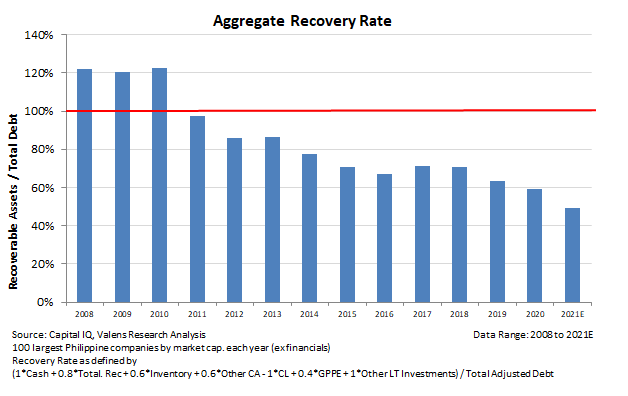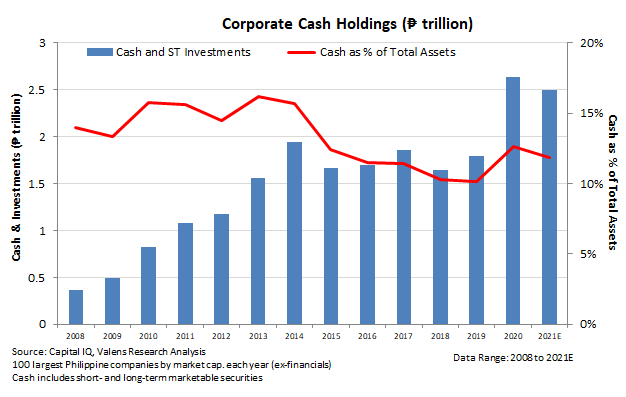MONDAY MACRO: The banking industry may not be right to remain conservative in its views

A well-functioning banking industry is crucial to an economy since it impacts all of the other industries. Banks provide businesses with a source of capital to grow, and they also provide investment instruments for savings to grow.
So when the banking industry’s sentiment remains conservative or pessimistic, and certain indicators point to concerns about further credit issues, investors get worried.
However, once we apply mosaic analysis on these indicators, we’ll see it’s not all gloom and doom for the sector—or for the Philippine economy.
Philippine Markets Daily:
The Monday Macro Report
Powered by Valens Research
As we’ve highlighted in our Monday Macro Report earlier this month, Philippine banks have been consistently pessimistic since the start of the pandemic, especially over the MSME sector.
There’s an economic reason behind this sentiment. While equity investors can lose money when an investment goes bad, they also have unlimited potential upside when an investment performs well.
On the other hand, creditors suffer all of the downside when a business defaults, but their upside is limited to the interest on the amount they lend—even when a business performs well.
As a result, the banking industry tends to be more conservative in their outlook relative to the rest of the economy.
Another reason why banks have been more pessimistic is that many important indicators of the industry’s health have been deteriorating.
One example is the Non-Performing Loan (NPL) ratio, an indicator we’ve discussed several times before. While it was only at 3.3% last November, the NPL ratio has now risen to 4.0% as of June 2021, more than double its 5-year average of 1.9%.
High levels of NPLs mean that banks have taken on bad quality loans. If they are unable to sell these to investors or other banks, banks will be more reluctant to give out loans in the future or will start charging higher rates to mitigate losses.
A high NPL ratio generally leads to a slower economic recovery since businesses find it harder to access credit in this environment.
Even in Valens’ own indicators, some are providing reasons for banks to hold a negative outlook.
Specifically looking at the Aggregate Recovery Rate chart, the top 100 companies in the Philippine Stock Exchange (PSE) have seen a steady decline in asset quality since 2017, and this is forecasted to fall further in 2021 to 49%.

The recovery rate is essentially the value of assets that could potentially pay off a company’s debts. This means in a potential default scenario, it is estimated that an asset sale would only be able to pay off half of the group’s debts.
The Aggregate Recovery Rate is concerning because only a decade ago, the top 100 companies in the PSE would not have had such an issue.
Furthermore, this low rate could mean either companies’ assets have declined considerably or that companies have become too aggressive in taking on more debt.
However, if we look at the capacity of the top 100 companies to immediately pay off debts, through their current cash holdings, the chances of a mass default scenario are actually slim.
Corporate cash holdings recorded a historical high of PHP 2.6 trillion in 2020 and is estimated to remain near that level in 2021 at PHP 2.5 trillion.

Compared to past years, companies are in a safer credit position today despite a declining Aggregate Recovery Rate—they have the capacity to easily address near-term debt maturities.
For long-term debt, as we’ve pointed out in our Aggregate Credit Cash Flow Prime article, this shouldn’t be problematic as long as companies can further improve their liquidity position prior to 2024.
About the Philippine Market Daily
“The Monday Macro Report”
When just about anyone can post just about anything online, it gets increasingly difficult for an individual investor to sift through the plethora of information available.
Investors need a tool that will help them cut through any biased or misleading information and dive straight into reliable and useful data.
Every Monday, we publish an interesting chart on the Philippine economy and stock market. We highlight data that investors would normally look at, but through the lens of Uniform Accounting, a powerful tool that gets investors closer to understanding the economic reality of firms.
Understanding what kind of market we are in, what leading indicators we should be looking at, and what market expectations are, will make investing a less monumental task than finding a needle in a haystack.
Hope you’ve found this week’s macro chart interesting and insightful.
Stay tuned for next week’s Monday Macro report!
Regards,
Angelica Lim
Research Director
Philippine Markets Daily
Powered by Valens Research
www.valens-research.com




